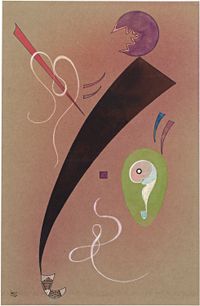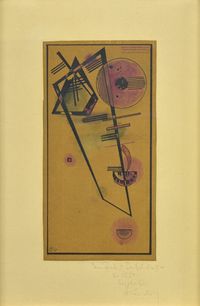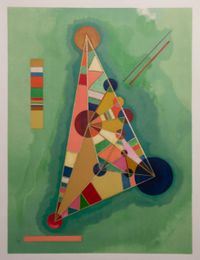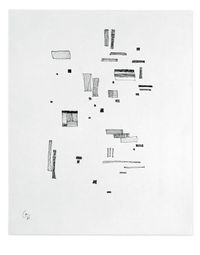Father of abstract painting Wassily Kandinsky advocated for an intuitive approach that liberated painting from realistic representation. He opted instead for spiritual expression, translating music and sound into colour on canvas.
Read MoreBorn in Moscow, Kandinsky grew up in an upper-class family with a penchant for music. As a child, he already showed great sensibilities in colour and sound. Kandinsky took piano and cello lessons and learned to draw from the age of five.
Still, he would not commit to painting for another 25 years, answering to his family's wishes to study law at the University of Moscow. After completing his degree in 1892, the artist joined the Moscow Faculty of Law. He managed an art-printing works on the side, the desire to paint still lingering.
After seeing Claude Monet's Haystack at Giverny (1866) in Moscow in 1895, Kandinsky left his law career to devote himself to painting. Monet's oil-on-canvas painting features a landscape rendered in vivid tones, poppy fields, and haystacks rolling into dusk, a lyrical rendition recovered in Kandinsky's paintings.
While studying traditional painting at the Munich Academy of Arts, Kandinsky began formulating theories of his own, informed by spirituality and the relationship between music and colour. In 1901, with three other artists, Kandinsky founded Phalanx, an artist association opposing conservative views of traditional art institutions.
Kandinsky travelled through Europe and northern Africa from 1903 to 1909, developing his own style influenced by the developing Expressionist movement. During this period, Kandinsky painted Der Blaue Reiter (The Blue Rider) (1903), which depicts a rider in a blue cloak traversing a green meadow. While retaining elements of realism, the painting marks a turn towards abstraction. With paint applied in short thick strokes that evoke movement, the painting was a departure from strict representation.
In 1909, Kandinsky founded the New Artists Association of Munich, which supported works deemed radical by traditional institutions. When Kandinsky's Der Blaue Reiter was rejected from the organisation's annual exhibition in 1911, he and fellow painter Franz Marc established a rival group also named Der Blaue Reiter. The association of nine artists was active until the outbreak of World War I, guided by ideas around the representation of sound and colour as a spiritual experience.
After World War I, Kandinsky returned to Russia. There, he was influenced by the Constructivist movement and had a son who lived until the age of three. Following the October Revolution of 1917, Kandinsky turned to the administration of educational programs and helped establish Moscow's Institute of Artistic Culture and Museum of Pictorial Culture.
Kandinsky felt removed from the avantgarde while his search for spirituality clashed with the utilitarian aesthetic promoted by the Communist government. When Walter Gropius invited Kandinsky to teach at the Weimar Bauhaus in Germany, he gladly accepted.
Kandinsky taught at the Bauhaus school in Berlin until the Nazi takeover in 1933. There, he reflected on the significance of geometric elements within painting, resulting in increasingly abstract works like Composition VIII (1923), in which figures, lines, and planes melt into a horizon of blue.
In 1926, Kandinsky published Point to Line to Plane, a theoretical work advocating for a scientific approach to painting, discarding emotive expression for constructed composition.
Kandinsky fled to Paris in the late 1930s. There, the painter experimented with biomorphic forms, departing from the harsh geometric shapes of his Bauhaus paintings.
Kandinsky's works fell out of favour with the avantgarde as the Parisian art scene was flooded with Cubist and Surrealist imagery. When Germany invaded France in 1940, Kandinsky left for the Pyrenees and then for Neuilly-sur-Seine, where he lived in seclusion, depressed that his paintings were not selling.
Kandinsky passed away from cerebrovascular disease in Neuilly-sur-Seine in 1944. While deemed controversial by many, the painter's work found supporters like Solomon R. Guggenheim during his lifetime and laid the foundations for much of the expressionist art of the 20th century.
Kandinsky's work is held in major institutions around the world including Museum of Modern Art, New York; The Guggenheim Museum, New York; Centre Pompidou, Paris; Hermitage Museum, St. Petersburg; The State Russian Museum, St. Petersburg; Pushkin Museum, Moscow; Kunstmuseum Basel; Stedelijk Museum, Amsterdam; Museo Nacional Centro de Arte Reina Sofía, Madrid; Galleria Nazionale d'Arte Moderna, Rome; Tate, London; The Albertina, Vienna; The National Museum in Belgrade; and Moderna Museet, Stockholm.
While many of the works Kandinsky made in Russia have not survived, his paintings from his time in Germany regularly surface in the New York auction market.
Elaine YJ Zheng | Ocula | 2021







